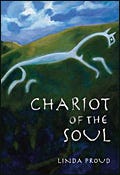Chariot of the Soul imagines the life of the first-century British prince Togidubnus, who may have been the ruler for whom the Fishbourne palace at Chichester was built. Although few specifics of his life are known, historical and archaeological evidence of his time underpins this richly atmospheric novel.
As portrayed here, Togidubnus is sent to Rome as a child hostage, where he grows up in the future emperor Claudius's household. As a young man, he returns to Britain ahead of Claudius's invasion force to urge British kings to support Rome. Long-standing economic ties and Rome's overwhelming military power persuade many British tribes to accept Roman rule, while a fragmented resistance effort led by Caratacus is doomed to fail.
Central to the story is the tension between the secularized Roman world in which the enforced worship of emperors undermines religious belief, and the mystical world of the Britons in which divinities are understood to inhabit springs, lakes and rivers, groves, hills and valleys―essentially every part of the land. Togidubnus's studies with the Roman philosopher Seneca teach him a detachment that ripens into mysticism after he returns to Britain, meets druids and remembers his mother's teachings. He comes to believe "that the gods of place are the place, are what makes it shimmer with beauty. They are the liquidity of water, the heat of the fire, the sap of the tree, the scent of the earth."
The dangers threatening Togidubnus, both in Rome and in Britain, are serious enough to keep readers hooked, but Chariot of the Soul is essentially a novel of character and ideas, both philosophical and spiritual. Its style recalls some of the finest novels about ancient Britain, from Rosemary Sutcliff's Sword at Sunset to Mary Stewart's Merlin trilogy—but with the benefit of further decades of archaeological findings to draw on. Readers hungry for more novels of that high quality will find Chariot of the Soul a worthy successor. (2018, 478 pages including a Historical Note)




